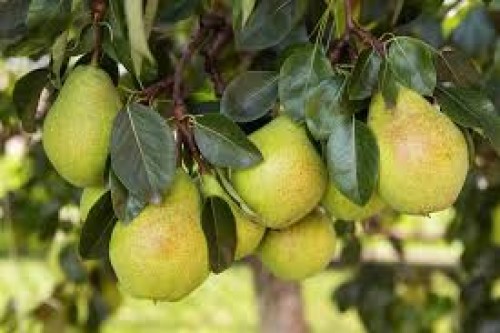off
-
Sold
-

out
Pear Plant: Uses, Care & Advantages
The Pear Plant (Pyrus communis) is a deciduous fruit tree known for producing sweet, juicy fruits with a delicate flavor. Pears are cultivated worldwide and come in many varieties. The tree is not only appreciated for its fruit but also for its elegant appearance, making it a great addition to both orchards and ornamental gardens.
Care of the Pear Plant
With proper care and attention, a pear tree can yield delicious fruits for decades. Here’s how to grow and maintain a healthy pear plant:
- Climate: Pears thrive in temperate climates with cool winters and warm summers.
- Sunlight: Full sun is essential—at least 6 to 8 hours of direct sunlight daily.
- Soil: Prefers deep, well-drained loamy soil. pH should be slightly acidic to neutral (6.0–7.0).
- Watering: Water deeply and regularly during the growing season. Reduce frequency in winter.
- Fertilization: Apply a balanced fertilizer in early spring. Use compost or organic manure yearly for added nutrients.
- Pruning: Prune during the dormant season to maintain shape, remove dead wood, and encourage air circulation.
- Pollination: Some varieties are self-pollinating, but cross-pollination from another pear tree improves yield.
- Pest & Disease Control: Monitor for pear psylla, codling moth, and fire blight. Use organic sprays and maintain good garden hygiene.
Advantages of the Pear Plant
- Nutritious Fruit: Pears are rich in fiber, Vitamin C, and antioxidants, making them a heart-healthy snack.
- Digestive Health: High fiber content supports digestion and gut health.
- Low Allergen Risk: Pears are hypoallergenic and safe for babies and sensitive individuals.
- Ornamental Value: The pear tree has beautiful white blossoms in spring and striking foliage in autumn.
- Productive Lifespan: A healthy pear tree can produce fruit for over 30 years.
- Environmental Benefits: Pear trees support pollinators and contribute to a biodiverse garden ecosystem.
Uses of Pears
- Fresh Eating: Eaten raw, pears are juicy, sweet, and refreshing.
- Culinary: Used in pies, jams, salads, tarts, and sauces for their soft texture and delicate taste.
- Juices & Smoothies: Pear juice is naturally sweet and hydrating.
- Canning & Preserving: Pears can be preserved for off-season use through canning or drying.
- Health Products: Found in baby food, fiber supplements, and low-sugar snacks due to their health profile.
Conclusion
The Pear Plant is both practical and beautiful, offering nutritious fruit and visual charm throughout the seasons. It’s a low-maintenance tree suitable for home gardens and orchards alike. With consistent care and occasional pruning, you can enjoy its sweet rewards for many years to come.